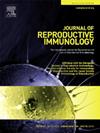聚(I:C)刺激细胞因子的产生,但不细胞迁移,在上皮外滋养细胞系
IF 2.9
3区 医学
Q3 IMMUNOLOGY
引用次数: 0
摘要
外滋养细胞参与螺旋动脉重塑和免疫特权,在妊娠期间发挥重要作用。因此,胞外滋养细胞功能障碍与多种妊娠并发症有关,如感染引起的母体免疫激活后引起的并发症。本研究的目的是提高我们对病毒感染如何影响胞外滋养细胞功能的理解。在一项随机、盲法实验中,将胞外滋养细胞HTR8/SVneo细胞暴露于多肌苷多胞苷酸(poly(I:C))中,多肌苷多胞苷酸是一种模拟病毒,可作为toll样受体(TLR)-3激动剂。将细胞暴露于浓度高达200 µg/ml的聚(I:C)中后,分析细胞毒性、白细胞介素(IL)-1β、IL-6、IL-8、RANTES、干扰素-γ、肿瘤坏死因子-α、人绒毛膜促性腺激素、黄体酮、雌二醇和细胞迁移。暴露于poly(I:C)导致HTR8/SVneo细胞培养上清中IL-6、IL-8和RANTES浓度显著升高,但对其他细胞因子的浓度没有显著影响。同样,暴露于聚(I:C)不影响激素分泌或细胞迁移。虽然poly(I:C)能够触发HTR8/SVneo细胞中细胞因子的释放,但对迁移没有影响,这表明TLR-3刺激可能不会影响上皮外滋养细胞的核心功能。这些结果间接表明IL-6、IL-8和RANTES也不影响迁移。未来的研究建议包括各种各样的免疫触发,以更好地绘制哪些可能与上皮外滋养细胞功能障碍有关。本文章由计算机程序翻译,如有差异,请以英文原文为准。
Poly(I:C) stimulates cytokine production, but not cell migration, in an extravillous trophoblast cell line
Extravillous trophoblasts play an important role during pregnancy due to their involvement in spiral artery remodeling and immune privilege. Extravillous trophoblast dysfunction is thus implicated in a variety of pregnancy complications, such as those arising after maternal immune activation caused by infection. The aim of this study was to improve our understanding of how viral infection might affect extravillous trophoblast functioning. In a randomized, blinded set-up, cells of the extravillous trophoblast cell line HTR8/SVneo were exposed to polyinosinic polycytidylic acid (poly(I:C)), a viral mimetic that acts as a toll-like receptor (TLR)-3 agonist. After exposure of the cells to poly(I:C) in concentrations up to 200 µg/ml, analyses were performed for cytotoxicity, interleukin(IL)-1β, IL-6, IL-8, RANTES, interferon-γ, tumor necrosis factor-α, human chorionic gonadotropin, progesterone, estradiol and cell migration. Exposure to poly(I:C) led to a significant increase in IL-6, IL-8 and RANTES concentrations in HTR8/SVneo cell culture supernatant, but did not significant affect concentrations of other cytokines included for measurement. Similarly, exposure to poly(I:C) did not affect hormone secretion or cellular migration. While poly(I:C) is capable of triggering the release of cytokines in HTR8/SVneo cells, the absence of an effect on migration suggests that the core function of extravillous trophoblasts might not be affected by TLR-3 stimulation. These results indirectly suggest that IL-6, IL-8 and RANTES do not affect migration either. Future research is recommended to include a wide variety of immunological triggers to better map which ones may be relevant to extravillous trophoblast dysfunction.
求助全文
通过发布文献求助,成功后即可免费获取论文全文。
去求助
来源期刊
CiteScore
6.30
自引率
5.90%
发文量
162
审稿时长
10.6 weeks
期刊介绍:
Affiliated with the European Society of Reproductive Immunology and with the International Society for Immunology of Reproduction
The aim of the Journal of Reproductive Immunology is to provide the critical forum for the dissemination of results from high quality research in all aspects of experimental, animal and clinical reproductive immunobiology.
This encompasses normal and pathological processes of:
* Male and Female Reproductive Tracts
* Gametogenesis and Embryogenesis
* Implantation and Placental Development
* Gestation and Parturition
* Mammary Gland and Lactation.

 求助内容:
求助内容: 应助结果提醒方式:
应助结果提醒方式:


